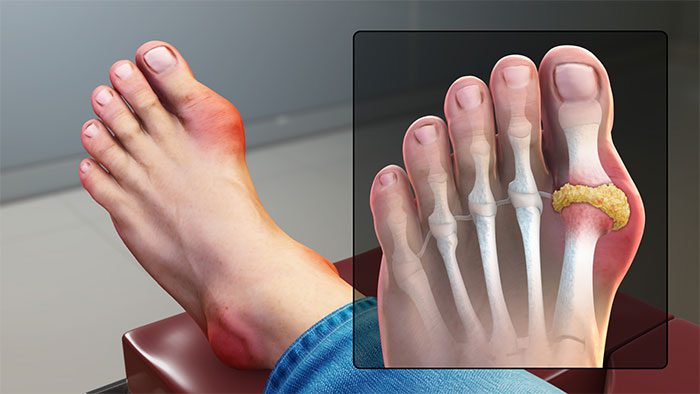Here are the differences between two types of arthritis: Gout and Rheumatoid Arthritis.
Both Gout and Rheumatoid Arthritis lead to joint inflammation and share some similar symptoms. However, their causes, treatments, and certain symptoms differ significantly.
Rheumatoid Arthritis

Rheumatoid Arthritis typically occurs in the hands, wrists, ankles, and knees on both sides of the body.
Rheumatoid Arthritis (RA) is an autoimmune condition where the immune system mistakenly attacks healthy cells in the synovial tissue or lining of the joints. This condition leads to inflammation, stiffness, pain, and swelling. Symptoms often occur in the hands, wrists, ankles, and knees on both sides of the body. If untreated, repeated swelling can cause joint damage. Symptoms may sometimes flare up and then subside on their own.
Initially, this condition may cause symptoms such as fatigue, fever, pain or stiffness in multiple joints, and weight loss. As the disease progresses, it can lead to long-term complications such as heart disease, high blood pressure, high cholesterol, type 2 diabetes, balance issues, and problems with the lungs, eyes, and other organs. RA typically affects women more than men.
Gout
Gout is another type of arthritis that causes severe pain in the big toe joint. In some cases, it can also affect the forefoot and ankle. Unlike Rheumatoid Arthritis, Gout occasionally attacks other joints in the body. Patients develop Gout when the uric acid level in the blood reaches dangerous levels. Certain medications and foods can also increase uric acid levels in the blood. This condition is more common in men than in women.

Gout is another type of arthritis that causes severe pain.
When excess uric acid crystals accumulate in the joints, patients may notice more pronounced symptoms of Gout. These symptoms can include: reduced range of motion, swelling, and pain (the affected joint is more painful when touched).
Diagnosis and Treatment of RA and Gout
Before starting treatment, it is important to identify the symptoms of Gout and Rheumatoid Arthritis. To diagnose Gout, doctors often order blood tests to measure uric acid levels. Meanwhile, Rheumatoid Arthritis can be difficult to diagnose in its early stages because its signs resemble those of many other diseases.
For treatment, patients with Gout are prescribed medications and advised to change their diet and lifestyle habits. In the case of Rheumatoid Arthritis, medications can help manage the condition. In addition to occupational therapy (OT), continuous monitoring and surgery are other options.



















































